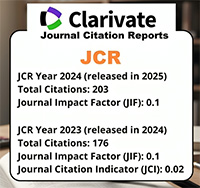Arracacia xanthorrhiza Bancr compounds decrease β-actin, hypoxia-inducible factor-1 and nitric oxide production in HeLa cells.
Los componentes de la Arracacia xanthorrhiza Bancr disminuyen las producciones de la actina β, del factor-1 inducible por la hipoxia y del óxido nítrico en células Hela.
Resumen
El tratamiento de pacientes con cáncer utilizando drogas-antineoplásicas presenta problemas relacionados con efectos colaterales indeseables. Se ha sugerido el uso de derivados de plantas naturales solas, o en combinación con drogas antineoplásicas existentes para obtener mejores resultados y disminuir los efectos colaterales. Así mismo, se ha reportado que el óxido nítrico (NO•), el factor-1 inducible por hipoxia (HIF-1) y la disminución de la expresión de la actina tienen un papel en la progresión del cáncer. También se ha reportado los efectos beneficiosos de lo polifenoles en varios desordenes orgánicos, incluyendo el cáncer. El objetivo de este estudio fue de-
terminar los efectos de los extractos procedentes de la Arracacia xanthorrhiza Bancr blanca (AXBB) y la variedad roja (AXBR) (compuestos ricos en polifenoles) en las concentraciones de la actina-beta, el NO• y el HIF-1 en cultivo de células Hela, para destacar sus posibles efectos antineoplásicos. A los cultivos de células Hela se les agregaron los extractos de las hojas de AXBB o AXBR (10-3 mg/mL, concentración final) y después de 24 horas de cultivo se determinaron las concentraciones de la actina-beta, el NO• y el HIF-1 por métodos inmunohistoquímicos, bioquímicos y western blot. Ambos extractos disminuyeron las concentraciones de la actina-beta, el NO• y el HIF-1 (p<0,001) de una manera similar al efecto del metotrexato. Estos resultados sugieren un efecto antineoplásico de estos extractos y destacan la posibilidad de ser usados para el tratamiento de las neoplasias.
Descargas
Citas
Cheng H, Wang L, Mollica M, Re AT, Wu S, Zuo L. Nitric oxide in cancer metastasis. Cancer Lett 2014; 353: 1–7. Sun MH, Han XC, Jia MK, Jiang WD, Wang
M, Zhang H, Han G, Jiang Y. Expressions of inducible nitric oxide synthase and matrix metalloproteinase-9 and their effects on angiogenesis and progression of hepatocellular carcinoma. World J Gastroenterol 2005; 11: 5931–5937.
Xie K, Huang S. Contribution of nitric oxide-mediated apoptosis to cancer metastasis inefficiency. Free Rad Biol Med 2003; 34: 969–986.
Sandau KB, Zhou J, Kietzmann T, Brune B. Regulation of the hypoxia-inducible factor 1alpha by the inflammatory mediators nitric oxide and tumor necrosis factor-alpha in contrast to desferroxamine and phenylarsine oxide. J Biol Chem 2001; 276: 39805–39811.
Mazur AJ, Nowak D, Mannherz HG, Malicka- Błaszkiewicz M. Methotrexate induces apoptosis in CaSki and NRK cells and influences the organization of their actin cytoskeleton. Eur J Pharmacol 2009; 613: 24–33.
Mills JC, Sone NL, Pittman RN. Extranuclear apoptosis: the role of the cytoplasm in the execution phase. J Cell Biol 1999; 146: 703–707.
Holdenrieder S, Stiebe P. Apoptotic markers in cancer. Clin Biochem 2004; 37: 605–617.
Bobo-García G, Davidov-Pardo G, Arroqui C, Vírseda P, Marín-Arroyo MR, Navarro M. Intra-laboratory validation of microplate methods for total phenolic content and antioxidant activity on polyphenolic extracts, and comparison with conventional spectrophotometric methods. J Sci Food Agric 2015; 95: 204-209.
Bhattacharya A, Kumar J, Hermanson K, Sun Y, Qureshi H, Perley D, Scheidegger A, Singh BB, Dhasarathy A. The calcium channel proteins ORAI3 and STIM1 mediate TGF-β induced Snai1 expression. Onco-target 2018; 9: 29468-29483.
Rao J, Li N. Microfilament actin remodelling as a potential target for cancer drug development. Curr Cancer Drug Targets 2004; 4: 267–283.
Walling J. From methotrexate to pemetrexed and beyond. A review of pharmacody-namic and clinical properties of antifolates. Invest New Drugs 2006; 24: 37–77.
Otrocka M, Verschueren H, Malicka-Błaszkiewicz M. The effect of methotrexate on actin and invasiveness of hepatoma Morris 5123 cells in culture. Acta Biochim Polonica 2001; 48: 1051–1060.
Desouza M, Gunning PW, Stehn JR. The actin cytoskeleton as a sensor and mediator of apoptosis. Bioarchitecture 2012; 2: 75–87.
Song Q, Wei T, Lees-Miller S, Alnemri E, Watters D, Lavin M F. Resistance of actin to cleavage during apoptosis. Proc Natl Acad Sci, USA 1997; 94: 157–162.
Folkman J. Role of angiogenesis in tumor growth and metastasis. Sem Oncol 2002; 29:15–18.
Choi YS, Cho HJ, Min JK, Pyun BJ, Maeng YS, Park H, Kim J, KimYM, Kwon YG. Interleukin-33 induces angiogenesis and vascular permeability through ST2/TRAF6-mediated endothelial nitric oxide production. Blood 2009; 114: 3117–3126.
Jun JC, Rathore A, Younas H, Gilkes D, Polotskyn VY. Hypoxia-inducible factors and cancer. Curr Sleep Med Rep 2017; 3: 1–10.
Zheng SS, Chen XH, Yin X, Zhang BH. Prognostic significance of HIF-1alpha expression in hepatocellular carcinoma: a meta-analysis. PloS One 2013; 8: e65753.
Parks SK, Cormerais Y, Marchiq I, Pouyssegur J. Hypoxia optimizes tumor growth by controlling nutrient import and acidic metabolite export. Mol Aspects Med 2016; 47–48: 3–14.
Luo D, Wang Z, Wu J, Jiang C, Wu J. The role of hypoxia inducible factor-1 in hepato-cellular carcinoma. BioMed Res Int 2014; 2014: 409272.
Andriantsitohaina R, Auger C, Chataigneau T, Étienne-Selloum N, Li H, Martínez M C, Schini-Kerth VB, Laher I. Molecular mechanisms of the cardiovascular protective effects of polyphenols. British J Nutr 2012; 108: 1532-1549.
Eberhardt MV, Lee CY, Liu RH. Antioxidant activity of fresh apples. Nature 2000; 405: 903–904.
Recio M, Andujar I, Rios J. Anti-inflammatory agents from plants: progress and potential. Curr Med Chem 2012; 19: 2088–2103.
Spagnuolo C, Russo M, Bilotto S, Tedesco I, Laratta B, Russo GL. Dietary polyphenols in cancer prevention: the example of the flavonoid quercetin in leukemia. Ann New York Acad Sci USA 2012; 1259: 95–103.
Vauzour D, Rodriguez-Mateos A, Corona G, Oruna-Concha MJ, Spencer JE. Polyphenols and human health: Prevention of disease and mechanisms of action. Nutrients 2010; 2: 1106–1131.
Yahfoufi N, Alsadi N, Jambi M, Chantal-Matar C. The immunomodulatory and anti-Inflammatory. Role of polyphenols. Nutrients 2018; 10: 1618-1641.





















